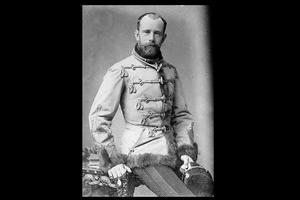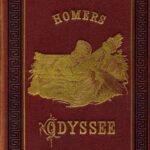Crown Prince Rudolf was born to be an emperor, but such was not to be. When he died unexpectedly in 1889, most called it suicide. Was it? Or was it a political assassination?
Rudolf Franz Karl Joseph was the only son of Franz Joseph I of Austria. He was well-educated, intelligent, interested in natural sciences, and, unlike his father, of a liberal bent. At the age of 23 he married the Princess Stephanie of Belgium, a granddaughter of the first king of Belgium, and a niece of the Empress of Mexico. Rudolf was smitten with his 17-year-old bride, but his mother didn’t like her. She called her das hassliche Trampeltier,”the ugly clumsy oaf.”
Before long, Rudolf didn’t like his bride much either. While Rudolf was intelligent and impulsive, Stephanie was conventional and formal. Soon Rudolf was taking mistresses and consoling himself with drink.
When Rudolf was 30, he purchased Mayerling, a country estate that he transformed into a hunting lodge. He also made the acquaintance of the Baroness Marie Vetsera (who preferred the Anglicized “Mary”), and she became his mistress. He was much taken with her, and, for her part, she was fanatically in love. It appears that their relationship was known to almost everyone in the royal circle, including Rudolf’s wife, who may have had a lover of her own. The Emperor objected, and, according to some reports, insisted that Rudolf break of all ties with the woman.
On the morning of January 30, 1889, Rudolf and Mary were found dead at Mayerling. Initially, the official story was that Rudolf had suffered a heart attack, and that Mary had simply disappeared. But too many people had seen the bullet hole in Rudolf’s head, and eventually it was admitted that he had committed suicide. Mary, it seems, had either committed suicide or been killed by Rudolf.
According to the police investigation, Mary’s death had preceded Rudolf’s by several hours, so it was obvious that she had not been the one who shot Rudolf. She had apparently known that she was going to die: she wrote letters to her mother, sister, and brother, all of which were found at Mayerling after her death. The letters were brought to the emperor, who gave them to Mary’s uncle, with the instruction that her mother would be allowed to read them for one hour only, after which they would be removed from her possession. Mary had told her mother that she felt she would be far happier dead than alive.
Mary’s body was surreptitiously removed from Mayerling and taken to a storeroom. Two days later two of her uncles smuggled the body out by walking it out between them — as if the girl were alive — and taking it by carriage to a nearby monastery. Mary’s upright body had a tendency to fall forward during the ride, so a broomstick was attached to it. Although Mary’s death may have been a suicide, special permission was obtained to bury her on sacred ground. (The whole procedure was orchestrated by an Abbott Grunbeck, whose papers and records were found to have mysteriously disappeared after his death in 1902.)
As for Rudolf, whose death was clearly considered a suicide, a special dispensation was received from the Vatican. His death was considered to have been an act of temporary “mental imbalance,” not a deliberate suicide. This enabled the family to bury him in the Imperial Crypt.
The two deaths were handled in such a truly bizarre manner that it was practically inevitable that a multitude of theories should arise. Was it a suicide pact between two lovers who couldn’t bear to be separated? Did Mary die as a result of a botched abortion, and Rudolf kill himself out of grief? Was Rudolf going mad as a result of syphilis, and chose to kill himself rather than endure the madness? Or was it some kind of political conspiracy?
The Empress Zita, widow of Emperor Karl, the last emperor of the Austro-Hungarian Empire, claimed that the murders were political assassinations. One theory is that Rudolf was murdered by Austrian security officials because of Rudolf’s pro-Hungarian ideas. Another theory claims that French agents killed him because he refused to help depose his father and replace him on the throne. Empress Zita, it should be noted, was not yet born at the time of the Mayerling incident, and claimed that her husband had told her that all the evidence had been locked away.
After the death of Archduke Rudolf, the line of succession passed to his uncle, Archduke Karl Ludwig, his father’s younger brother. Karl Ludwig renounced his rights in favor of his son, Franz Ferdinand. Archduke Franz Ferdinand, you may recall, was assassinated in Sarajevo in 1914 — one of the precipitating events of World War I.
Sources: Chase’s Calendar of Events, 2011 Edition: The Ultimate Go-To Guide for Special Days, Weeks, and Months, Editors of Chase’s Calendar of Events; http://en.wikipedia.org/wiki/August_21; http://en.wikipedia.org/wiki/Rudolf,_Crown_Prince_of_Austria; http://en.wikipedia.org/wiki/The_Mayerling_Incident; http://en.wikipedia.org/wiki/Baroness_Mary_Vetsera; http://en.wikipedia.org/wiki/Princess_St%C3%A9phanie_of_Belgium; http://androom.home.xs4all.nl/index.htm?dead/story004.htm; http://popcultureinstitute.blogspot.com/2009/01/pop-history-moment-mayerling-incident.html; http://en.wikipedia.org/wiki/Archduke_Franz_Ferdinand_of_Austria; http://www.vienna-life.com/news/news/26-The_Mayerling_Incident; http://annalsofunsolvedcrimes.blogspot.com/2010/06/mayerling-mystery.html.


